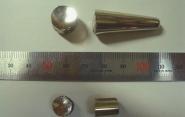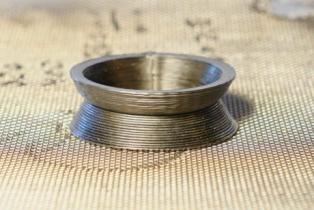Quicker, More Precise Way to Find Metallic Glasses

Metallic glasses are being developed for a broad range of applications. The relatively new material is stronger than even the best metals, but with the pliability of plastic.
 However, finding the right elements to make metallic glasses has proven a time-consuming task. A team of researchers, including Jan Schroers, professor of mechanical engineering & materials science, has devised a way to dramatically reduce the amount of time that it takes. Their results are published in Nature Materials.
However, finding the right elements to make metallic glasses has proven a time-consuming task. A team of researchers, including Jan Schroers, professor of mechanical engineering & materials science, has devised a way to dramatically reduce the amount of time that it takes. Their results are published in Nature Materials.
Metallic glasses owe their properties to their unique atomic structures: when metallic glasses cool from a liquid to a solid, their atoms settle into a random arrangement and do not crystallize the way traditional metals do. But the glass-forming ability (GFA) - that is, how easy a metal or alloy can be turned into a glass - is complex and poorly understood. And trying to quantify the GFA of a material has been experimentally elaborate and computationally challenging. As a consequence, the ideal combination of properties has been found in only a few alloys, and current use of metallic glass is limited to highly specialized applications. To unleash their potential, a much wider range of alloys must be characterized.
The team of researchers has devised a method that takes much of the time and the trial-and-error out of the process. They found that with conventional X-ray diffraction, they could figure out how readily an alloy can be converted to glass. For the study, they processed about 5,700 X-ray diffraction patterns from 12 alloy systems - an unprecedented amount of experimental data, both in quantity and in consistent quality.
“We can extract information about the glass from an X-ray diffraction pattern, which is very easy to measure,” Schroers said. “In the past, people could only state whether or not the material is a glass or not. We can now distinguish between glasses by looking at the width of the first peak. This width tells us how easy it is to form a glass.”
From a practical standpoint, this means a dramatic reduction in the time it takes to find new metallic glasses. Using conventional methods, determining whether a material makes a better glass than another requires a “really, really elaborate” process.
“Now you do one X-ray diffraction, and you know how good the glass is,” he said. “There are thousands of different crystals, and we can distinguish between each and describe its characteristics. And now we have the chance to distinguish between glasses. Not quite like crystals, but looking at the spectrum, we can draw conclusions about the glasses’ glass forming ability - so we have a easily measurable structural signature of a property.”

